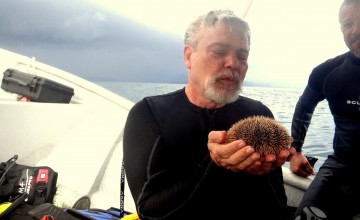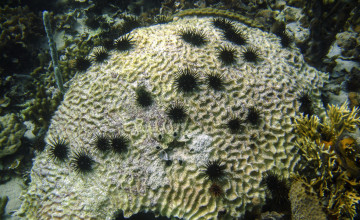
Projects and Stories
Recent Publications
Hiller, A. and H. A. Lessios. 2017. Phylogeography of Petrolisthes armatus, an invasive species with low dispersal ability. Scientific Reports 7: 3359. 10.1038/s41598-017- 03410-8
Gene Flow in Coral Reef Organisms of the Tropical Eastern Pacific, 2016
Research Focus
I am interested in the evolution and the ecology of marine organisms, particularly sea urchins, but also fishes, crustaceans, and corals. I focus on the processes that give rise to new species, and I use molecular tools to reconstruct the history of populations and of genes. Typically, this involves reconstructing the trajectories of population genetic and phylogenetic processes in relation to geographic distributions of populations, followed by the assessment of barriers (ecological or molecular) that maintain the genetic integrity of sympatric species. In this effort, I have been greatly aided by the history of the Isthmus of Panama, which separated inhabitants of two oceans at a known time.
Contact
How do new species arise and maintain their integrity?
Species generally arise when gene flow is disrupted by a geological or oceanographic barrier. When species come in contact again, they will not merge if they have evolved differences that prevent the transfer of genes. Examples in marine organisms might be specialization in different habitats, difference in spawning cycles, incompatibility of gametes, or developmental dysfunction of hybrids.
What molecules confer compatibility of gametes of the same species and incompatibility between gametes of different species?
We focus on sea urchins (model organisms for developmental biology), because their external fertilization greatly simplifies the number of factors that need to be taken into account. My colleagues and I are studying the evolution of bindin, a molecule on the sperm that is recognized by the egg, and EBR1 and the “350kD protein”, two molecules on the egg that interact with bindin to effect fertilization. To a lesser extent, we have also worked with speract, a molecule released by the egg to attract sperm, as well as its receptor on the sperm.
What are the evolutionary forces that result in barriers to genetic exchange between species?
Species are sets of populations reproductively isolated from other populations, so speciation is the evolution of barriers to genetic exchange. Such barriers need not be molecular interactions of gametes. A long-term study of two genera of sea urchins each with two sympatric sister species in the Caribbean is seeking to establish whether these species occupy different habitats, whether they reproduce at different times (and the factors that control their reproduction), whether their gametes are incompatible, or whether their hybrids are developmentally unstable (and the genes responsible for their lower fitness).
B.A., Harvard College, 1973
M.Phil., Yale University, 1976
Ph.D., Yale University, 1979
H.L. Lessios and G. Hendler. 2022. Mitochondrial phylogeny of the brittle star Genus Ophioderma. Nature Scientific Reports 2022. 12:5304. doi.org/10.1038/s41598-022-08944-0
S.E. Coppard, H. Jessop, H.A. Lessios. 2021. Phylogeography of the sea urchin genus Echinothrix: patterns of dispersal, connectivity, colouration and cryptic speciation across the Indo-Pacific. Nature Scientific Reports 22:26568. doi.org/10.1038/s41598-021-95872-0
T.J. Carrier, H.A. Lessios, A. M. Reitzel. 2020c. Eggs of echinoids separated by the Isthmus of Panama harbor divergent microbiota. Marine Ecology Progress Series. 648:169-177. doi.org/10.3354/meps13424
L. Geyer and H.A. Lessios. 2020b. Slow evolution under purifying selection in the gamete recognition protein bindin of the sea urchin Diadema. Nature Scientific Reports. 10:9834 DOI:101038/s41598-020-66390-2
A. Hiller and H.A. Lessios. 2019d. Marine species formation along the rise of Central America: The anomuran crab Megalobrachium Molecular Ecology 29:413-428. DOI: 10.1111/mec.15323
N. Mongiardino Koch, S. Coppard, H.A. Lessios, D. Briggs, R. Mooi, G. Rouse. 2018b A phylogenomic resolution of the sea urchin tree of life. BMC Evolutionary Biology (2018) 18:189 doi.org/10.1186/s12862-018-1300-4
H. A. Lessios and I. Baums. 2017a. Gene flow in coral reef organisms of the tropical eastern Pacific. In: P.W. Glynn, I.C. Enochs, and D. Manzello (eds.) pp. 477-499 In: Coral Reefs of the Eastern Pacific. Springer-Verlag. DOI: 10.1007/978-94-017-7499-4_16
A. O’Dea, H. A. Lessios, A.G. Coates, R.I. Eytan, L.S. Collins, A.L. Cione, A. de Queiroz, D.W. Farris, R.D. Norris, S.A. Restrepo-Moreno, R.F. Stallard, M.O. Woodburne, O.Aguilera, M.-P. Aubry, W.A. Berggren, A.F. Budd, M.A. Cozzuol, S.E. Coppard, H.Duque-Caro, S.Finnegan, G.M. Gasparini, E.L. Grossman, K.G. Johnson, L.D. Keigwin, N.Knowlton, E.G. Leigh, J.S. Leonard-Pingel, P.B. Marko, N.D. Pyenson, P.G. Rachello-Dolmen, E.Soibelzon, L. Soibelzon, J.A.Todd, G.J. Vermeij, J.B.C. Jackson. 2016c. Formation of the Isthmus of Panama. Science Advances, 2: 8, e1600883. DOI: 10.1126/sciadv.1600883
H. A. Lessios. 2016a. The great Diadema antillarum die-off: 30 years later. Annual Review of Marine Science 8:267-283 doi:10.1146/annurev-marine-122414-033857
H. A. Lessios, S. Lockhart, R. Collin, G. Sotil, P. Sanchez-Jerez, K. S. Zigler, A. F. Perez, M. J. Garrido, L.B. Geyer, G. Bernardi, V. D. Vacquier, R. Haroun, B.D. Kessing. 2012a. Phylogeography and bindin evolution in Arbacia, a sea urchin genus with an unusual distribution. Molecular Ecology, 21:130-144 DOI:10.1111/j.1365-294X.2011.05303.x
H. A. Lessios. 2011. Speciation genes in free-spawning marine invertebrates. Integrative and Comparative Biology, 51: 456-465


